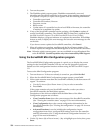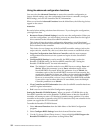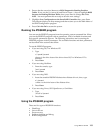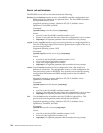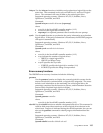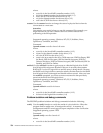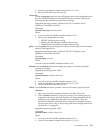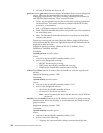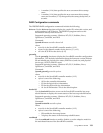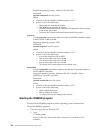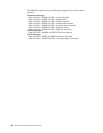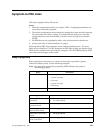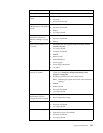138 Hardware Maintenance Manual: xSeries 250
• sid is the SCSI ID for the device (0–15)
getevent Use the getevent function to display information about various unexpected
events. IBM uses the soft and hard event logs for development and
debugging purposes only. The device event log contains event counters for
each attached physical device. These counters include:
• Parity: An unexpected event occurred while data was being transferred
on the SCSI bus. This usually indicates a problem with the SCSI cable,
connectors, or terminators.
• Soft: A SCSI device detected a check-condition event.
• Hard: The SCSI controller detected an unexpected event. The controller is
the most likely cause.
• Misc: The ServeRAID controller detected an event that was most likely
caused by the device.
The device event log also provides Predictive Failure Analysis (PFA) alerts,
which indicate that the device has signaled the ServeRAID controller that it
might fail in the near future.
Supported operating systems: Windows NT, OS/2, NetWare, Linux,
OpenServer, UnixWare, and DOS
Command:
ipssend getevent controller options
where:
• controller is the ServeRAID controller number (1–12)
• options is the designated event log:
— DEVICE for the device event log
— SOFT for the ServeRAID controller soft event log
— HARD for the ServeRAID controller hard event log
selftest The selftest function is used to direct a controller or a device to perform its
self-test.
Supported operating systems: DOS
Command:
ipssend selftest controller options
where:
• controller is the ServeRAID controller number (1–12)
• options is the designated self-test:
— AD for the ServeRAID controller self-test
—PD channel sid for the device self-test
Note: channel represents the drive channel, and sid is the SCSI ID for
the device.
startdely Use the startdely function to set the number of drives in a group to start up
simultaneously and to set the delay in seconds between the startup of these
groups of drives.
Supported operating systems: DOS
Command:
ipssend startdely controller options
where:
• controller is the ServeRAID controller number (1–12)
• options is one of the following:
— ? displays the concurrent drive startup count and the delay time.



